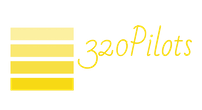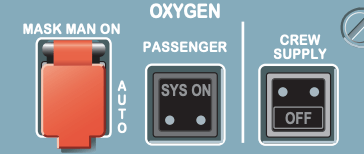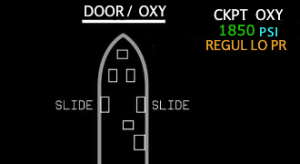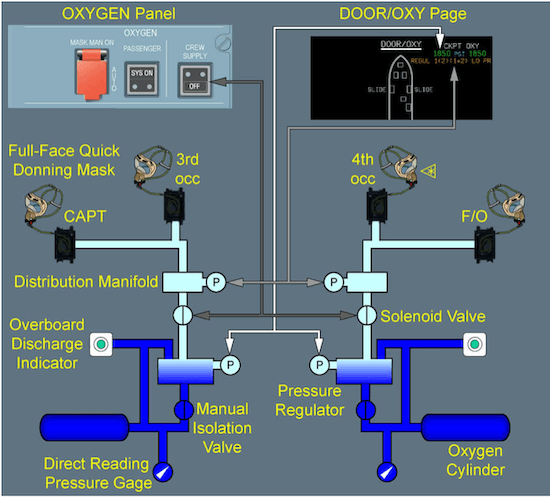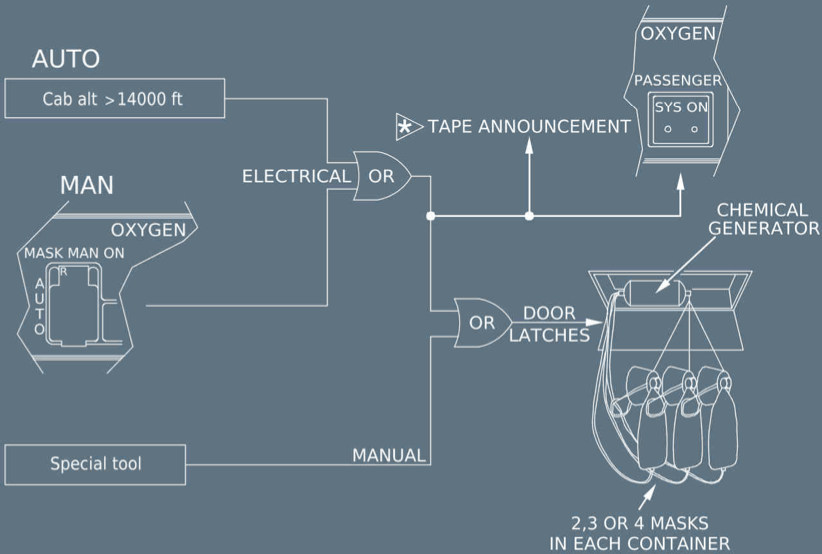General
The A-320 oxygen system consists of:
- Cockpit oxygen system (flight crew and observers).
- Cabin oxygen system (cabin crew and passengers).
- Portable oxygen system (crew protection during on board emergencies and first aid purposes).
Cockpit Oxygen System
The A-320 cockpit oxygen system consists of:
- A high pressure cylinder which provides oxygen to the cockpit.
- A pressure regulator, connected directly to the cylinder, to regulate the pressure the oxygen is delivered to the masks.
- Two overpressure safety valves to vent oxygen overboard if the pressure becomes too high.
- A solenoid valve that allows the crew to shut off the oxygen supply.
- Three or four full-face quick-donning masks stowed in readily-accessible boxes adjacent to the crew-members’ seats.
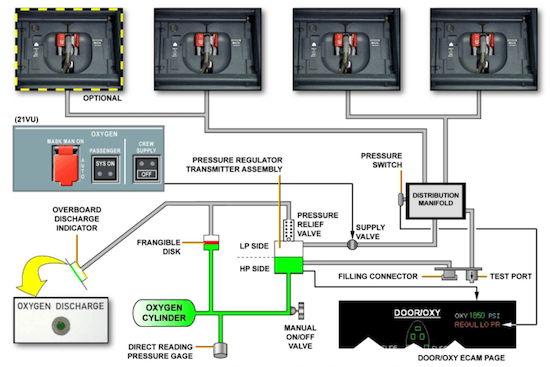
A-320 Cockpit Oxygen System
The
A-320neo cockpit oxygen system is separated into two sub-systems; one for the Captain and the 3rd Occupant and, one for the First Officer and the 4th Occupant. Therefore, there are two high pressure cylinders, two pressure regulators, four overpressure safety valves and two solenoid valves.
Mask Operation
The crew member squeezes the red grips to pull the mask out of its box and, this action causes the mask harness to inflate. As soon as the left flap door opens, the mask is supplied with oxygen.
A Pressure Regulator is mounted on each cockpit mask.
- When the N/100% selector is set to 100% position (pressed - normal position in flight), the user breathes pure oxygen at all cabin altitudes.
- When the N/100% selector is set to N position (released), the user breathes a mixture of cabin air and oxygen up to the cabin altitude at which the regulator supplies 100 % oxygen.
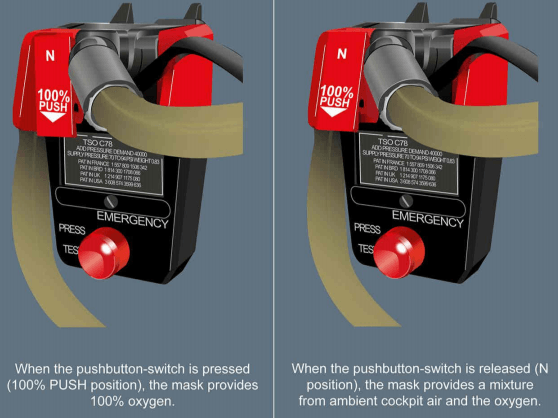
Mask Pressure Regulator
The EMERGENCY selector creates on overpressure which eliminates condensation or fogging of the mask, and prevents smoke, smell or ashes from entering the mask.
- Pressing this knob generates an overpressure for a few seconds.
- Turning the knob, in the direction of the arrow, generates a permanent overpressure.
Overpressure supply is automatically started, when the cabin altitude exceeds 30000 ft and the N/100% selector is set to 100 % position.
Mask Stowage
After the oxygen mask has been used:
- Place the mask in the stowage box and close the doors.
- Press the "RESET/TEST" button in order to cut off the oxygen, and the mask microphone.
- Once the "RESET/TEST" button is released, check that the "OXY ON" flag disappears.
- Press the EMERGENCY selector and check that the blinker remains black.
- Set the N/100% selector at the 100% position.
Standard Operating Procedures
- The oxygen masks must be tested before first flight of the day or whenever there is a crew change.
- During oxygen mask test, ensure that the N/100% selector is set at the 100% position.
Cabin Oxygen System
The
Cabin Oxygen masks are located in containers above the passenger seats, in the lavatories, in each galley, and at each cabin crew station. Each container has an electrical latching mechanism that opens automatically to allow the masks to drop, if the cabin pressure altitude exceeds 14,000 ft (+250, -750 ft).
Chemical generators produce the oxygen. The generation of oxygen begins when the passenger pulls the mask towards the passenger seat. Each generator feeds a group of 2, 3, or 4 masks.
The mask receives pure oxygen under positive pressure for about 13 min, 15 min, or 22 min, depending on the aircraft configuration, until the generator is exhausted.
The chemical reaction used for oxygen generation creates heat. Therefore, the smell of burning, smokes and cabin temperature increase may be associated with the normal operation of the oxygen generators.
The flight crew can override the automatic latching mechanism and launch the masks from the cockpit by pressing the guarded "MASK MAN ON" pushbutton on the overhead panel. There is also a manual release tool that allows cabin crew to open the doors manually in case of electrical failure.
Portable Oxygen System
The portable oxygen system is located on the right back side of the cockpit and ensures the eyes and respiratory system protection of one flight crew member when fighting a fire and in case of smoke or noxious gas emissions or cabin depressurization.
The effective time of use is approximately 15 minutes.
NOTE
There are different types of portable oxygen systems (smoking hoods or PBEs). Please refer your company's FCOM for more details.
Oxygen Overhead Panel
Crew Supply pb
This pushbutton controls the solenoid valve.
- ON: The valve is open, and supplies low pressure oxygen to the masks (normal position in flight).
- OFF: The valve is closed, and the white light comes on.
Passenger SYS ON light
This light comes on in white, when the control for the oxygen mask doors is activated.
MAN MASK ON pb
- AUTO: The mask doors open automatically, when the cabin altitude exceeds 14000 ft.
- Pressed: The mask doors open.
ECAM SYSTEM DISPLAY
CKPT OXY indication
It is normally white. It becomes amber, when:
- Pressure goes below 300 psi.
- Low oxygen pressure is detected.
- The overhead panel’s OXYGEN CREW SUPPLY pushbutton is OFF.
OXYGEN pressure indication
- It is in green, when the pressure is ≥ 600 psi.
- It pulses in green, when the pressure is < 600 psi (the DOOR/OXY SD page is automatically displayed).
- It is in amber, when the pressure is < 300 psi.
- On ground, an amber half frame appears when oxygen pressure is < 1000 psi. In this case, the flight crew must check that the remaining quantity is not below the minimum (Refer to FCOM LIM-OXY Minimum Flight Crew Oxygen Pressure).
REGUL LO PR indication
It appears in amber, if oxygen pressure on the low-pressure circuit is low (50 psi).
NOTE
The OXYGEN pressure indications mentioned above maybe are different at your aircraft. Please refer at your company's FCOM.
